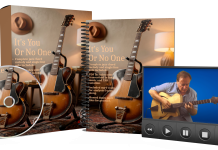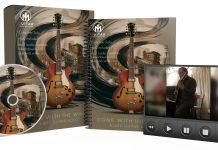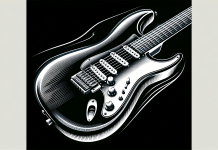This post may contain affiliate links. As an Amazon associate, Google associate as well as associate for other programs, Guitar & Music Institute may earn commissions from qualifying purchases.

Welcome to “Mastering Major Scales for Guitar”! In this friendly guide, you’ll discover the fundamentals of major scales and how to master them on your guitar. With easy-to-follow instructions and practical exercises, you’ll soon be playing fluidly and confidently. Whether you’re a beginner or looking to refine your skills, this article will provide the tools and inspiration you need to take your playing to the next level. So, grab your guitar, tune up, and let’s dive into the world of major scales together!
Mastering Major Scales for Guitar
Have you ever wondered how guitarists effortlessly move up and down the fretboard, playing melodies that seem to flow naturally across different chords? The secret often lies in mastering major scales. While it might seem challenging at first, understanding and practicing major scales can significantly enhance your guitar playing and open up a world of musical possibilities.
What is a Major Scale?
The major scale is one of the foundational elements in Western music. It’s a sequence of seven notes that follows a specific pattern of whole steps (two frets on a guitar) and half steps (one fret on a guitar). The structure of a major scale is:
Whole – Whole – Half – Whole – Whole – Whole – Half
Why Learn Major Scales?
Learning major scales on the guitar has numerous benefits:
- Improvisation: They provide a basis for soloing and improvisation.
- Chord Shapes: Understanding major scales helps you to recognize and form chord shapes.
- Music Theory: They serve as a gateway to grasping advanced music theory.
- Finger Strength and Dexterity: Practicing scales strengthens your fingers and enhances your overall playing technique.
Breaking Down the Major Scale
To effectively master major scales, it’s essential to understand their construction.
Musical Intervals
Intervals are the building blocks of scales. They measure the distance between two notes. In a major scale, these intervals are made up of whole steps (W) and half steps (H). Here’s the breakdown:
- Root (start) note
- Whole step to the second note
- Whole step to the third note
- Half step to the fourth note
- Whole step to the fifth note
- Whole step to the sixth note
- Whole step to the seventh note
- Half step back to the root note (now one octave higher)
C Major Scale Example
Let’s apply this interval pattern to the C major scale. The C major scale contains no sharps or flats, making it an ideal starting point.
C – D – E – F – G – A – B – C
Intervals: C (Root) – Whole – D – Whole – E – Half – F – Whole – G – Whole – A – Whole – B – Half – C (Octave)
Common Major Scales on Guitar
Here are some of the most common major scales you will encounter, with their note sequences and corresponding intervals:
| Scale | Notes | Intervals |
|---|---|---|
| C Major | C – D – E – F – G – A – B – C | W – W – H – W – W – W – H |
| G Major | G – A – B – C – D – E – F# – G | W – W – H – W – W – W – H |
| D Major | D – E – F# – G – A – B – C# – D | W – W – H – W – W – W – H |
| A Major | A – B – C# – D – E – F# – G# – A | W – W – H – W – W – W – H |
| E Major | E – F# – G# – A – B – C# – D# – E | W – W – H – W – W – W – H |
| F Major | F – G – A – Bb – C – D – E – F | W – W – H – W – W – W – H |
Fingering Major Scales on Guitar
For efficient practice and to maximize your learning, understanding proper finger positioning is crucial.
One Octave Major Scale Patterns
Here’s a range of one octave open string major scale patterns:
 The CAGED system is a powerful tool for understanding scales on the guitar. It derives its name from the common open chord shapes: C, A, G, E, and D. By learning these five shapes and how they connect, you can play any scale in any position on the neck.
The CAGED system is a powerful tool for understanding scales on the guitar. It derives its name from the common open chord shapes: C, A, G, E, and D. By learning these five shapes and how they connect, you can play any scale in any position on the neck.
Major Scale in CAGED Positions
Here’s how you can visualize and play the C major scale in seven CAGED position:

Beyond the Basics: Advanced Major Scale Techniques
Once you’re comfortable with the basic shapes and patterns, it’s time to take your playing to the next level.
Modes of the Major Scale
Modes are variations of the major scale starting from different notes within the scale. Here are the seven modes derived from the C major scale:
- Ionian (C)
- Dorian (D)
- Phrygian (E)
- Lydian (F)
- Mixolydian (G)
- Aeolian (A)
- Locrian (B)

Each mode has a unique sound and can be used to create different musical moods.
Connecting Scale Patterns
Connecting scale patterns across the neck is crucial for fluid improvisation. Practice moving between different CAGED shapes seamlessly. Here is an example exercise:
- Start in the C shape at the 3rd fret.
- Move to the A shape at the 5th fret.
- Transition to the G shape at the 7th fret.
Playing with Metronomes
Using a metronome can help you develop timing and rhythm. Start slow, focusing on accuracy. Gradually increase the tempo as you become more comfortable with the scale.
Improvisation Exercises
Approach improvisation as a conversation:
- Play a simple melody using the major scale.
- Experiment with adding different rhythms and notes.
- Respond to your own “musical questions” with “musical answers.”

Practical Tips for Mastering Major Scales
Consistent Practice
Like learning any new skill, consistent practice is key. Dedicate a set amount of time each day to practice scales.
Record Yourself
Recording your practice sessions allows you to hear your progress and identify areas for improvement.
Learn Songs and Solos
Apply major scales to songs and solos. Learning pieces of music that incorporate major scales makes the practice both enjoyable and practical.
Play with Others
Playing with other musicians offers real-world applications of scales. Jam sessions, bands, or even online collaborations can provide invaluable experience.
Example Practice Routine
Here’s a sample routine to get you started:
- Warm-up: 5 minutes with a metronome at a slow tempo, playing the C major scale in different positions.
- Scale Practice: 20 minutes, focusing on one major scale and playing it in multiple positions across the neck.
- Exercise Modes: 15 minutes on the modes of the C major scale.
- Improvisation: 10 minutes, using the C major scale to create solos over a backing track.
- Cool Down: 5 minutes of relaxed playing of familiar tunes using major scales.
Mastering Major Scales: The Road Ahead
Mastering major scales for guitar is a journey, not a destination. The more you practice, the more intuitive they will become. Patience and persistence are essential. Remember that every great guitarist started with the basics, and mastering the major scales is an essential step in your musical development.
Final Note
Stay curious and keep experimenting. Your guitar journey is uniquely yours, and the major scale is a powerful tool to express your musical ideas. Enjoy the process, and happy playing!
This post may contain affiliate links. As an Amazon associate, Google associate as well as associate for other programs, Guitar & Music Institute may earn commissions from qualifying purchases.


























